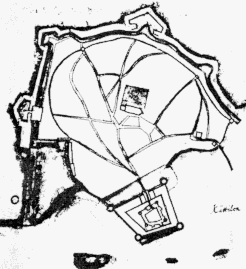Meet the Middle Ages
BackStreets and alleys

Most towns founded on the Baltic Sea in the 14th century had straight streets and a central square. This was the German model for a town. The square was the marketplace of the town and had permanent stalls. All streets started from the square and led to different parts of town. The street leading from the harbour to the square became the main street. Many older towns have such a main street with smaller streets leading from it. This is the case in towns like Visby and Sigtuna.
The streets and lay-out of the town had of course a lot to do with the surrounding landscape. All towns could not be constructed according to the same model. Many towns had a more irregular street system than was planned from the beginning. The streets on the outskirts of the towns were generally rather crooked and winding.
The main street could be quite broad, 8-12 ells (5-7 meters), and paved with stones. There could be a gutter in the middle of the street which gathered up water and garbage. Other streets were narrower, paved with stones, wooden planks or logs. Between the streets, there were narrow alleys and passages. They were often muddy and dirty, since they were not paved.